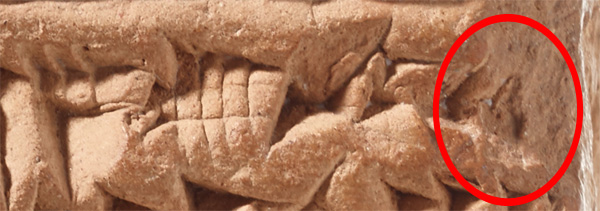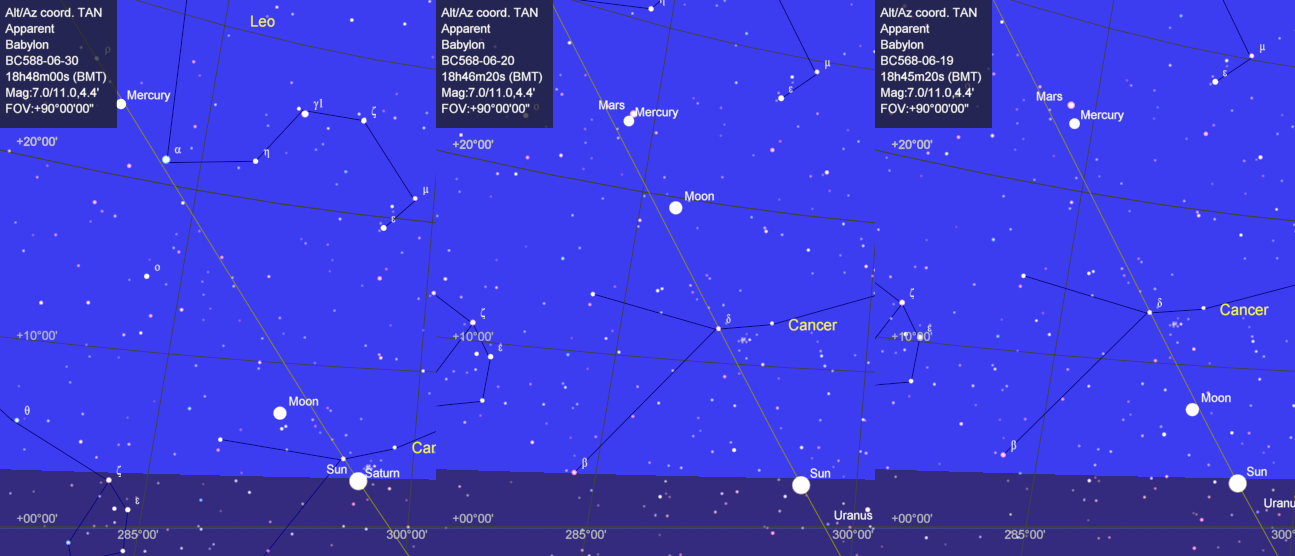Note B
sunset to moonset: 20°
In 568 BC this time is out by +15%, Just 3 days ago it was 100% accurate, and 46 Days ago the measurement was -7% out.
Did you know that of the 75 times recorded on Astronomical Diaries before -346 BC only 17 are within 5% of the time they are said to be recording? They can fluctuate between -700% and +510% of the time they are said to be recording. See article Timed Events.
Note C
At that time, Mars and Mercury were 4 cubits in front of α [Leonis ...]
In the year 568 BC Mars and Mercury are above the Moon, setting after it. This is what you would expect especially since the tablet translates "At that time" (Remember this for later).
The symbol that would indicate what Mars and Mercury are "in front of" is missing, the translations say that they were "4 cubits in front of α [Leonis ...]". Notice the [Square brackets] this means that the translators added this information. Below is an image of the end of line 12.

Photo credit: Olaf M. Teßmer, Vorderasiatisches Museum
What did the tablet say? The damaged part doesn't look like the start of the LUGAL symbol  used earlier. What were the planets in front of? Were the two planets balanced? It doesn't say.
used earlier. What were the planets in front of? Were the two planets balanced? It doesn't say.
Note D
Moon position 4
the moon became visible behind Cancer

| behind Cancer | Moon | Cancer | ° | ||||
|---|---|---|---|---|---|---|---|
| BC588-06-30 19:09 | 1506837.17292 | behind | |||||
| BC568-06-20 19:40 | 1514132.19444 | behind | |||||
Position 3 | Position 4 | Position 5
Note E
At that time, Mars and Mercury were 4 cubits in front of α [Leonis ...]
The following symbols translated as "Mars and Mercury" (AN u GU4.UD);



could read d ulBABBAR (DINGIR UL BABBAR) which is normally a name for Jupiter, but can also mean Mars - P. Felix Gössman; Planetarium Babylonicum (1950) pg 107
Here is a copy of the hand drawing from Planetarium Babylonicum (1950):

The AN/DINGIR symbol could be used in the same way as with dSAG.ME.GAR on the tablet, both being unique to VAT4956, and continues the use of an Alias for Mars.
The tablet is broken so what Mars is "in front of" is not stated.
Note F
| Symbol | Syllables | Meanings |
|---|---|---|
 |
SIG | SIG |
 |
ušu3 ba3 es2 sin |
šalāšā: thirty, 30 half the moon |
 |
ušu3 ba3 es2 sin |
šalāšā: thirty, 30 half the moon |
 |
UB | Translated as: behind; tubqu: a corner. |
 |
NAGAR | alluttu: a crab, constellation of Cancer. |
 |
IGI | naṭālu: (to be able) to see , to look at, to gaze ; to observe (the sky); to be visible; ina maḫar: before (someone), in the presence, in front of - The Assyrian Dictionary, Volume 10, M, Part I, (1977) pg 106 |
 |
KA | KA |
 |
MAŠ BA7 BAR |
ḫuzālu: gazelle kid; ṣerru: snake, possible name for Hydra constellation; Māšu: twin, Gemini; bīru: goat half Nissan, first month - on VAT4956 there seems to be no distinction between BAR and MAŠ |
 |
niš MAN šamaš2 |
twenty Mars Sun |
 |
NA | do, sky, be, heaven, man, not, lie, |
 |
LAGAB RI3 GUR4 niĝin2 ellag KUR4 |
block; excess thick encircle, total bibbu: Mercury KUR4 = ba'lu which means either ba'ālu: to be abnormally large, to become bright or shine brightly; or ba'ūlu: great, important; - The Assyrian Dictionary, Volume 2, B (1965) pg 1, 184 |
 |
DU DE6 GUB TUM6 |
go bring stand, sheep |
   |
I.NU.SU2 | translated as: At that time |
    |
AN.U.GU4.UD d ulBABBAR |
d ulBABBAR (DINGIR UL BABBAR) normally a name for Jupiter (without DINGIR), but can also mean Mars - P. Felix Gössman; Planetarium Babylonicum (1950) pg 107 |
 |
4 | 4 |
 |
U2 kuš3 |
load, horn unit |
    |
ina IGI | naṭālu: (to be able) to see , to look at, to gaze ; to observe (the sky); to be visible; ina maḫar: before (someone), in the presence, in front of - The Assyrian Dictionary, Volume 10, M, Part I, (1977) pg 106 |
Note G
A. The moon observations.
5. On the I Sivan the moon became visible behind the crab: it was wide, 1h 20m was its period of visibility after sunset (Vs. 12). New moon June 19, 6h early. Airu [Month II] had a duration of 29d, the 1. Sivan starts June 20 evening. The statement "the moon was wide" fits this late date (see No. 4 just now). June 20, 7h evening:
- Moon λ= 102°.0 ß= +1°.5
- ε Cancri λ= 91°.7 ß=+1°.0
☉ U 7h.00, ☾ U 8h.53; the time difference between Setting of the sun and setting of the moon 1h32m.
TRANSLATION FROM: Paul V. Neugebaner und Ernst F. Weidner (1915) Ein astronomischer Beobachtungstext aus dem 37. Jahre Nebukadnezars II (- 567/66).
Modern Results
SkyCharts- BC568-06-20 19h00m00s ( +03 )
- Moon: L: +101°04'49" B:+00°57'28"
- ε Cancri: L: +91°45'31" B:+00°54'06"
Sunset 19:05; Moonset 20:38 = 01:33
Front Line 11 | Front Line 12 | Front Line 13
